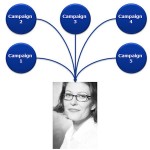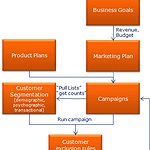The path to successful Trigger Based Marketing often seems to be strewn with road blocks but is it? In this post I will examine the six most often cited road-blocks and demolish them.
This is a follow-up to my recent post The 5 Critical Factors for Interactive Marketing Success. In life there is Yin and Yang and this is the Yin to the last post’s Yang.
As I noted in the last post, the value that can be driven from trigger based marketing (also called interactive marketing) is very substantial: conversion rates of 45%, 35% reductions in direct marketing costs are just the tip of the iceberg. None the less, many people are so concerned about the perceived road blocks to trigger marketing that they enter a state of paralysis and so don’t leverage that value.
Read on to avoid this state.
1. “Our data is not good enough”
If I and a dime for every time I had heard this… I’ll let you in on a secret, no-one is happy with their data. Just because your data is not perfect doesn’t mean that you can’t get started though.
Work with what you have: the glass is half full. You’ll be surprised what you can do.
2. “How do we pull all of the data into one place so we can get a whole of customer view?”
Okay this is a tough one, no doubt, but again it starts with what you have and build from there. With the advent of cloud based solutions like HubSpot it is a relatively straightforward process to hook your automation solution into different areas of your customer database.
It’s not perfect but it will certainly get you moving on triggered marketing.
3. “I’m already implementing a new campaign every quarter / month / week and that’s really tough how am I going to build 400!”
One of the real secrets of event based marketing is that over time you build a larger and larger library of campaigns. And all of the campaigns run all of the time.
So instead of having to think up a brand new campaign every week/month/quarter you steadily build up your library. You still need to develop campaigns on a daily basis but you will be reusing them over and over.
Early on you should focus on identifying triggers that will deliver repeatable, automatable, higher volume campaigns. This is the Pareto principle in action once again.
When you look back at the end of 12 months you will be surprised how many campaigns you have running.
4. “Determining the treatment to perform can be really hard!”
It is not well known but finding triggers to use in event driver marketing can be the easy part of the process. It is often much harder to determine what to do when a trigger is hit.
Once again you need to look at the long term process. Yes determining the best treatment for a trigger can be difficult but once it’s done, it’s done for the long term.
5. “Won’t my customers be unhappy if they think we’re looking over their shoulder all the time?”
This is all a matter of how you execute.
Calling up a customer and saying “Hey I noticed that you deposited a large lump sum in your account this week – do you want to open up a term deposit (or CD)?,” is a poor customer experience.
However, including a brochure about the “great new term deposit rates” that you have in the customer’s next statement would be a great experience.
You need to think about how you will deliver the treatment in a way that does not make them feel like you are Big Brother.
6. “We really can’t afford all of the new systems required”
“We can’t get on the IT roadmap for 12 months.”
Until the advent of software as a service (SaaS) or cloud based solutions this was a real issue. The upfront capital cost and getting on the IT implementation roadmap were real barriers to implementation.
Now, however, things have changed. Invoicing for these solutions is an operational not a capital expense. Plus, typically a new instance of the platform can be created in a few days.
You will need some IT support but the size and timing of that support is dramatically reduced over what was required even a few years ago.
I've created an Excel Customer Lifetime Value Calculator: Download Here




